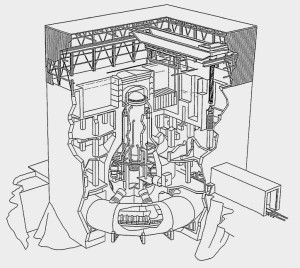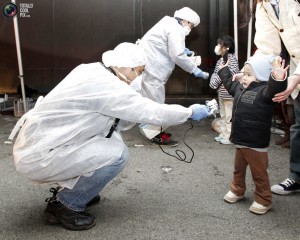The Reactor itself
The Fukushima nuclear reactors consisted of four boiling water reactors or (BWR)’s. Built to produce energy. Heat from the reactor was used to boil water, which produced steam, which turned turbines that produced electricity. These reactors operated at 285 degrees Celsius, and used Uranium as their fuel source. Uranium which has a melting point of 2800 degrees Celsius was pressed into a puck. This puck was comprised of not only Uranium but a combination of elements that created a stable nuclear reaction, and worked to retain radioactive particle. These pucks were contained in a fuel rod made of Zircaloy; this fuel rod acted as the second barrier against radioactive products and had a melting point of 1200 degrees Celsius. Several hundred of these rods made up the reactors core. The core was housed in a pressurized steel vessel which was the third barrier against radioactive particles. The entire system: the reactors core, the water being boiled, the turbine, and cooling systems were in a containment structure that was intended to withstand and contain an entire core meltdown. The containment structure was air tight and made of steel and concrete, there was even a second concrete structure poured over the basic containment structure to insure control. Lastly the reactor structure had a weather resistant shell.
March 11, 2011
On 3/11/2011 an 8.9 earthquake hit Japan. This earthquake was more powerful than what the Fukushima nuclear reactors were built to withstand. The rectors were programmed to automatically shut down when an earthquake of this scale occurred. With the nuclear reactions stopped the cooling systems still had deal with the seven percent heat that emanated from the core. Diesel power generators began to run the cooling systems, and had the job under control until they were wiped out by a massive tidal wave. For the next eight hours Batteries that were built into the containment center powered the cooling systems. After the batteries died the cooling capabilities were severally limited.
The Day’s That Fallowed
The important thing was to keep the reactor cool, and to maintain the structural integrity of the fuel rods. Since cooling was not functioning at this point the control room decided to release steam that was building in the reactor. Over the last few months it has been stated that the control room was ineffective at making decisions throughout this disaster. One of the points of argument is that if they had began releasing steam earlier then they did the reactors would not have had such extensive meltdowns as ended up occurring. However the decision to release the building gasses was also the decision to release radioactive particles into the atmosphere, and hind sight is twenty-twenty.
Anyways in the months that fallowed not only was steam containing radioactive particles released into the atmosphere, but radioactive water as well. The sea water had been added to the reactor to replace the steam that was being lost and was released into the ocean when the containment methods that were in place to hold the contaminated water reach capacity. Now seven months later massive amounts of contaminated water and steam have been released due to leaks in hoses, overcapacity containment, and too much pressure in the system. The Fukushima reactors will not be entirely cold until next year, and the world will have to deal with the extra radioactive particles in our environment for the rest of the century.
In recent days Japan has began to acknowledge that the radiation emitted from this incident is far greater then they have been stating. The accident level is a a seven, the highest possible ratting. Japan is now accepting that the 12 mile evacuated area is and will be uninhabitable for decades to come. Radiation levels far past the proclaimed dead zone have been found to have uninhabitable levels of radiation. And people refuse to consume food grown in the areas surrounding the evacuation zone. Though press in this country is limited on the happenings of the Fukushima nuclear disaster the country of Japan is still far from deliverance from this wound. 
Here is a link to an interview with Dr. Michio Kaku in which he discusses the Fukushima incident as of June 2011: http://www.youtube.com/watch?v=QQa2Ivz8i8I
Resources:
http://mdn.mainichi.jp/mdnnews/news/20110910p2a00m0na008000c.html
http://bravenewclimate.com/2011/03/13/fukushima-simple-explanation/
http://www.nirs.org/fukushima/crisis.htm
Pics:
http://www.google.com/imgres?q=fukushima+nuclear+power+plant+disaster&um=1&hl=en&client=firefox-a&rls=org.mozilla:en-US:official&biw=1440&bih=710&tbm=isch&tbnid=2QIgOjJECnXACM:&imgrefurl=http://totallycoolpix.com/2011/03/japan-earthquake-and-tsunami-nuclear-disaster-looms-large/&docid=6Zoba6PotxXnDM&w=990&h=793&ei=MhyBTtfTHOPm0QGD8cmoAQ&zoom=1&iact=hc&vpx=960&vpy=357&dur=1032&hovh=201&hovw=251&tx=103&ty=110&page=2&tbnh=150&tbnw=187&start=16&ndsp=18&ved=1t:429,r:16,s:16
http://www.beyondnuclear.org/storage/post-images/bwr-mk1i.jpg?__SQUARESPACE_CACHEVERSION=1299944680212

I liked how you explained how the reactor works before explaining the disaster. It made the story a lot easier to understand. The organization of the blog is also well done. Overall this blog was very informative.
This blog is really good. The detail is amazing and the description of the meltdown was great. The telling of what happened after the disaster was a good way to put an end to the blog. Great Job.
I enjoyed how you described what happened after the disaster, not just during it